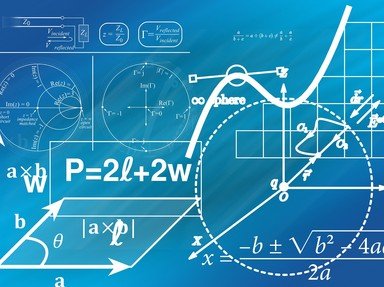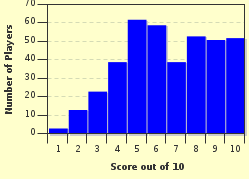Quiz Answer Key and Fun Facts
1. An arithmetic sequence is one in which the difference between any two consecutive terms of the sequence is constant. I will call this "common difference" d. For example, for the sequence 2, 6, 10, 14, ... we have d = 4 since 6 - 2 = 4, 10 - 6 = 4, 14 - 10 = 4, and so on. Now you try one:
What is the value of d for the following sequence:
1, 11, 21, 31, 41, ... ?
2. The common difference -- that is, one term minus the preceding term -- in an arithmetic sequence doesn't have to be positive. For example, what is the common difference in the following arithmetic sequence?
98, 89, 80, 71, ...
3. In general, we would use subscript notation to indicate the nth term of a sequence: a_n denotes the nth term of a certain sequence. For example, if I use the letter b to represent the terms in the sequence
3, 8, 13, 18, 23, ...
then b_1 = 3 (first term), b_2 = 8 (second term), and so on. So for this sequence, what is the value of b_6 ?
4. A sequence of real numbers can be defined as a function whose domain is the set of natural numbers (the numbers 1, 2, 3, ...) and whose range is a subset of the set of real numbers. This may seem like a strange definition, but it makes perfect sense - if you input a positive integer (say 5), the output will be that term of the sequence (in this case the fifth term), and you only have one output for each input, hence a sequence of numbers really represents a function. Now let's consider these arithmetic sequences I've been describing. If we let n denote the independent variable (a positive integer), what type of function of n does an arithmetic sequence represent?
5. There is a formula in general for the nth term a_n of an arithmetic sequence given the first term a_1 and the common difference d:
a_n = a_1 + (n - 1)d
For example, consider the sequence 1, 8, 15, 22, 29, ... .
Its first term a_1 = 1 and its common difference d = 7. Suppose we wanted the 100th term of this sequence - well, we'd just use the above formula:
a_100 = 1 + (100 - 1)*7 = 694.
What is the 2008th term of the above sequence?
6. The formula a_n = a_1 + (n - 1)d can be used to give a formula for the general term of the arithmetic sequence. For example, the sequence
3, 15, 27, 39, 51, ...
has a_1 = 3 and common difference d = 12, hence a formula for the general term is given by a_n = 3 + (n - 1)*12 which simplifies:
a_n = 12n - 9
Now your turn: Which of the following is the general term b_n of the sequence
20, 18, 16, 14, 12, ... ?
7. Now suppose I give you the formula for the general term of a certain arithmetic sequence:
a_n = 3n + 17
What is the first term a_1 of this sequence?
8. Now let's look at other uses for the formula for the nth term of an arithmetic sequence. Suppose we are given that the first term of an arithmetic sequence is 5 and the tenth term of the sequence is 77. What is the fourteenth term of this sequence? To answer this question, we use the formula to find the common difference d:
a_n = a_1 + (n - 1)d
Substituting, you get 77 = 5 + 9d. Solving, you get d = 8. Now plug this back into the formula above to get the fourteenth term:
a_14 = 5 + (14 - 1)*8 = 109.
Now it's your turn. Suppose an arithmetic sequence has first term 1 and fifteenth term 99. What is the fourth term of this sequence?
9. Recall that the formula for the nth term a_n of an arithmetic sequence is given by
a_n = a_1 + (n - 1)d
This time, suppose we're given that the tenth term of an arithmetic sequence is 28 and the eighteenth term of the arithmetic sequence is 44. What is the first term of this sequence?
10. Now here's one to think about: A certain arithmetic sequence consists entirely of positive integers. For this sequence, the first term a_1 = 1 and the number 2008 appears somewhere in the sequence. How many different arithmetic sequences have these properties? You will need to make use of the formula for the nth term a_n of an arithmetic sequence: a_n = a_1 + (n - 1)d
Source: Author
rodney_indy
This quiz was reviewed by FunTrivia editor
crisw before going online.
Any errors found in FunTrivia content are routinely corrected through our feedback system.

